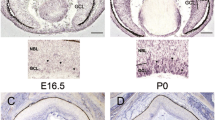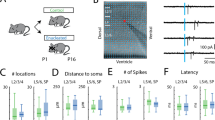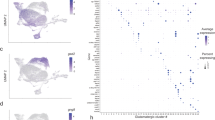Abstract
The cellular mechanisms by which the axons of individual neurons achieve their precise terminal branching patterns are poorly understood. In the visual system of adult cats, retinal ganglion cell axons from each eye form narrow cylindrical terminal arborizations restricted to alternate non-overlapping layers within the lateral geniculate nucleus (LGN)1–3. During prenatal development, axon arborizations from the two eyes are initially simple in shape and are intermixed with each other; they then gradually segregate to form complex adult-like arborizations in separate eye-specific layers by birth4,5. Here we report that ganglion cell axons exposed to tetrodotoxin (TTX) to block neuronal activity during fetal life fail to form the normal pattern of terminal arborization. Individual TTX-treated axon arborizations are not stunted in their growth, but instead produce abnormally widespread terminal arborizations which extend across the equivalent of approximately two eye-specific layers. These observations suggest that during fetal development of the central nervous system, the formation of morphologically appropriate and correctly located axon terminal arborizations within targets is brought about by an activity-dependent process.
This is a preview of subscription content, access via your institution
Access options
Subscribe to this journal
Receive 51 print issues and online access
$199.00 per year
only $3.90 per issue
Buy this article
- Purchase on Springer Link
- Instant access to full article PDF
Prices may be subject to local taxes which are calculated during checkout
Similar content being viewed by others
References
Hickey, T. L. & Guillery, R. W. J. comp. Neurol. 156, 239–254 (1974).
Sur, M. & Sherman, S. M. Science 218, 389–391 (1982).
Bowling, D. B. & Michael, C. R. J. Neurosci. 4, 198–216 (1984).
Shatz, C. J. J. Neurosci. 3, 482–499 (1983).
Sretavan, D. W. & Shatz, C. J. J. Neurosci. 6, 234–251 (1986).
Shatz, C. J. & Stryker, M. P. Science 242, 87–89 (1988).
Foster, R. E., Connors, B. E. & Waxman, S. G. Devl Brain Res. 3, 371–386 (1982).
Stryker, M. P. & Harris, W. J. Neurosci. 6, 2117–2133 (1986).
Sanderson, K. J. J. Comp. Neurol. 143, 101–118 (1971).
Schmidt, J. T. & Tieman, S. B. Cell. Molec. Neurobiol. 5, 5–35 (1985).
Dubin, M. W., Stark, L. A. & Archer, S. M. J. Neurosci. 6, 1021–1036 (1986).
Reh, T. A. & Constantine-Paton, M. J. Neurosci. 5, 1132–1143 (1985).
Ricco, R. V. & Matthews, M. A. Neuroscience 16, 1027–1039 (1985).
Cohan, C. S. & Kater, S. B. Science 232, 1638–1640 (1986).
Lipton, S. A., Frosch, M. P., Phillips, M. D., Tauck, D. L. & Aizenman, E. Science 239, 1293–1296 (1988).
Law, M. I. & Constantine-Paton, M. J. Neurosci. 1, 741–759 (1981).
Donovan, A. J. Comp. Neurol. exp. Eye Res. 5, 249–254 (1966).
Shatz, C. J. & Kirkwood, P. A. J. Neurosci. 5, 1378–1397 (1984).
Galli, L. & Maffei, L. Science 242, 90–91 (1988).
Sretavan, D. W. & Shatz, C. J. J. Comp. Neurol. 255, 386–400 (1987).
Author information
Authors and Affiliations
Additional information
To whom reprint requests should be sent.
Rights and permissions
About this article
Cite this article
Sretavan, D., Shatz, C. & Stryker, M. Modification of retinal ganglion cell axon morphology by prenatal infusion of tetrodotoxin. Nature 336, 468–471 (1988). https://doi.org/10.1038/336468a0
Received:
Accepted:
Issue Date:
DOI: https://doi.org/10.1038/336468a0
This article is cited by
-
Primary visual cortex projections to extrastriate cortices in enucleated and anophthalmic mice
Brain Structure and Function (2014)
-
Zic2 regulates the expression of Sert to modulate eye-specific refinement at the visual targets
The EMBO Journal (2010)
-
Effects of trkB knockout on topography and ocular segregation of uncrossed retinal projections
Experimental Brain Research (2009)
-
cAMP oscillations and retinal activity are permissive for ephrin signaling during the establishment of the retinotopic map
Nature Neuroscience (2007)
-
Ephrin-As and neural activity are required for eye-specific patterning during retinogeniculate mapping
Nature Neuroscience (2005)
Comments
By submitting a comment you agree to abide by our Terms and Community Guidelines. If you find something abusive or that does not comply with our terms or guidelines please flag it as inappropriate.



